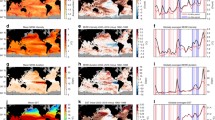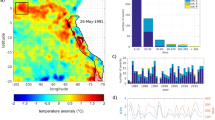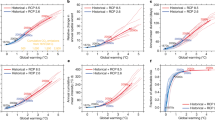Abstract
Marine heatwaves (MHWs) are prolonged high-temperature extreme events in the ocean that can be devastating to marine life and seriously impact climate systems and economies. This paper describes the accessibility, content, characteristics, and potential applications of an MHW dataset to facilitate its use in scientific research. Daily intensities of global MHWs from 1982 to 2020 were analyzed using gridded SST data sourced from the National Oceanic and Atmospheric Administration (NOAA) Optimum Interpolation (OI) SST V2 high-resolution (0.25°) dataset. The analysis shows a linear increase in the frequency of MHWs in most ocean regions of the world as well as significant interdecadal changes. This data product can be used as a basic dataset to study the seasonal to decadal changes in extreme ocean events and explore the effects of global warming on the surface layers of oceans during the last 40 years.
摘 要
海洋热浪(MHW)是海洋中持续的高温极端事件,会对海洋生物的生存等造成毁灭性影响,并严重影响气候系统和社会经济。本文介绍了全球高分辨率海洋热浪数据库的建立、内容、潜在应用。该数据库是基于NOAA日平均海表温度OISST_V2观测资料,通过改进对海洋热浪关键特征参数的定义,进而建立了1982-2020年全球0.25度海洋热浪日数据。该数据集明确体现了海洋热浪的爆发频次在全球大多数海域显著增长,并具有年际-年代际变化特征。该数据产品可为研究近40年来海洋极端事件季节至年代际变化、探索全球变暖对海洋表层影响提供基础数据。
Article PDF
Similar content being viewed by others
Avoid common mistakes on your manuscript.
Data availability statement and sharing policy. The data that support the findings of this study are openly available in the Science Data Bank at https://www.scidb.cn/en/s/nqauYn (doi: https://doi.org/10.11922/sciencedb.00872). Users are encouraged to download and share the datasets. All the datasets are free.
References
Amaya, D. J., A. J. Miller, S. P. Xie, and Y. Kosaka, 2020: Physical drivers of the summer 2019 North Pacific marine heatwave. Nature Communications, 11(1), 1903, https://doi.org/10.1038/s41467-020-15820-w.
Arafeh-Dalmau, N., G. Montaño-Moctezuma, J. A. Martínez, R. Beas-Luna, D. S. Schoeman, and G. Torres-Moye, 2019: Extreme marine heatwaves alter kelp forest community near its equatorward distribution limit. Frontiers in Marine Science, 6, 499, https://doi.org/10.3389/fmars.2019.00499.
Benthuysen, J. A., E. C. J. Oliver, M. Feng, and A. G. Marshall, 2018: Extreme marine warming across tropical Australia during austral summer 2015–2016. J. Geophys. Res., 123(2), 1301–1326, https://doi.org/10.1002/2017JC013326.
Berkelmans, R., G. De’Ath, S. Kininmonth, and W. J. Skirving, 2004: A comparison of the 1998 and 2002 coral bleaching events on the great barrier reef: Spatial correlation, patterns, and predictions. Coral Reefs, 23(1), 74–83, https://doi.org/10.1007/s00338-003-0353-y.
Bond, N. A., M. F. Cronin, H. Freeland, and N. Mantua, 2015: Causes and impacts of the 2014 warm anomaly in the NE Pacific. Geophys. Res. Lett., 42(9), 3414–3420, https://doi.org/10.1002/2015GL063306.
Cheung, W. W. L., and T. L. Frölicher, 2020: Marine heatwaves exacerbate climate change impacts for fisheries in the northeast Pacific. Scientific Reports, 10(1), 6678, https://doi.org/10.1038/s41598-020-63650-z.
Coleman, M. A., A. J. P. Minne, S. Vranken, and T. Wernberg, 2020: Genetic tropicalisation following a marine heatwave. Scientific Reports, 10(1), 12726, https://doi.org/10.1038/s41598-020-69665-w.
Dalton, S. J., and Coauthors, 2020: Successive marine heatwaves cause disproportionate coral bleaching during a fast phase transition from El Niño to La Niña. Science of the Total Environment, 715, 136951, https://doi.org/10.1016/j.scitotenv.2020.136951.
Di Lorenzo, E., and N. Mantua, 2016: Multi-year persistence of the 2014/15 North Pacific marine heatwave. Nature Climate Change, 6(3), 1042–1047, https://doi.org/10.1038/nclimate3082.
Frölicher, T. L., and C. Laufkötter, 2018: Emerging risks from marine heat waves. Nature Communications, 9(1), 650, https://doi.org/10.1038/s41467-018-03163-6.
Frölicher, T. L., E. M. Fischer, and N. Gruber, 2018: Marine heatwaves under global warming. Nature, 560(7718), 360–364, https://doi.org/10.1038/s41586-018-0383-9.
Garrabou, J., and Coauthors, 2009: Mass mortality in Northwestern Mediterranean rocky benthic communities: Effects of the 2003 heat wave. Global Change Biology, 15(5), 1090–1103, https://doi.org/10.1111/j.1365-2486.2008.01823.x.
Gupta, A. S., and Coauthors, 2020: Drivers and impacts of the most extreme marine heatwave events. Scientific Reports, 10(1), 19359, https://doi.org/10.1038/s41598-020-75445-3.
Hobday, A. J., and Coauthors, 2016: A hierarchical approach to defining marine heatwaves. Progress in Oceanography, 141, 227–238, https://doi.org/10.1016/j.pocean.2015.12.014.
Holbrook, N. J., and Coauthors, 2019: A global assessment of marine heatwaves and their drivers. Nature Communications, 10(1), 2624, https://doi.org/10.1038/s41467-019-10206-z.
Hu, S. Y., L. J. Zhang, and S. M. Qian, 2020: Marine heatwaves in the arctic region: Variation in different ice covers. Geophys. Res. Lett., 47, e2020GL089329, https://doi.org/10.1029/2020GL089329.
Hu, Z. Z., A. Kumar, B. Jha, J. S. Zhu, and B. H. Huang, 2017: Persistence and predictions of the remarkable warm anomaly in the northeastern Pacific Ocean during 2014–16. J. Climate, 30(2), 689–702, https://doi.org/10.1175/JCLI-D-16-0348.1.
Jentsch, A., J. Kreyling, and C. Beierkuhnlein, 2007: A new generation of climate-change experiments: Events, not trends. Frontiers in Ecology and the Environment, 5(7), 365–374, https://doi.org/10.1890/1540-9295(2007)5[365:ANGOCE]2.0.CO;2.
Laufkötter, C., J. Zscheischler, and T. L. Frölicher, 2020: High-impact marine heatwaves attributable to human-induced global warming. Science, 369(6511), 1621–1625, https://doi.org/10.1126/science.aba0690.
Marbà, N., G. Jordà, S. Agustí, C. Girard, and C. M. Duarte, 2015: Footprints of climate change on mediterranean sea biota. Frontiers in Marine Science, 2, 56, https://doi.org/10.3389/fmars.2015.00056.
Oliver, E. C. J., J. A. Benthuysen, N. L. Bindoff, A. J. Hobday, N. J. Holbrook, C. N. Mundy, and S. E. Perkins-Kirkpatrick, 2017: The unprecedented 2015/16 Tasman Sea marine heatwave. Nature Communications, 8, 16101, https://doi.org/10.1038/ncomms16101.
Oliver, E. C. J., and Coauthors, 2018: Longer and more frequent marine heatwaves over the past century. Nature Communications, 9(1), 1324, https://doi.org/10.1038/s41467-018-03732-9.
Pearce, A. F., and M. Feng, 2013: The rise and fall of the “marine heat wave” off Western Australia during the summer of 2010/2011. J. Mar. Syst., 111–112, 139–156, https://doi.org/10.1016/j.jmarsys.2012.10.009.
Piatt, J. F., and Coauthors, 2020: Extreme mortality and reproductive failure of common murres resulting from the northeast Pacific marine heatwave of 2014–2016. PLoS One, 15(1), e0226087, https://doi.org/10.1371/journal.pone.0226087.
Reynolds, R. W., T. M. Smith, C. Y. Liu, D. B. Chelton, K. S. Casey, and M. G. Schlax, 2007: Daily high-resolution-blended analyses for sea surface temperature. J. Climate, 20(22), 5473–5496, https://doi.org/10.1175/2007JCLI1824.1.
Scannell, H. A., A. J. Pershing, M. A. Alexander, A. C. Thomas, and K. E. Mills, 2016: Frequency of marine heatwaves in the North Atlantic and North Pacific since 1950. Geophys. Res. Lett., 43(5), 2069–2076, https://doi.org/10.1002/2015GL067308.
Smale, D. A., and Coauthors, 2019: Marine heatwaves threaten global biodiversity and the provision of ecosystem services. Nature Climate Change, 9, 306–312, https://doi.org/10.1038/s41558-019-0412-1.
Smith, K. A., C. E. Dowling, and J. Brown, 2019: Simmered then boiled: Multi-decadal poleward shift in distribution by a temperate fish accelerates during marine heatwave. Frontiers in Marine Science, 6, 407, https://doi.org/10.3389/fmars.2019.00407.
Sorte, C. J. B., A. Fuller, and M. E. S. Bracken, 2010: Impacts of a simulated heat wave on composition of a marine community. Oikos, 119(12), 1909–1918, https://doi.org/10.1111/j.1600-0706.2010.18663.x.
Varela, R., L. Rodríguez-Díaz, M. de Castro, and M. Gómez-Gesteira, 2021: Influence of Eastern Upwelling systems on marine heatwaves occurrence. Global and Planetary Change, 196, 103379, https://doi.org/10.1016/j.gloplacha.2020.103379.
Waliser, D. E., 1996: Formation and limiting mechanisms for very high sea surface temperature: Linking the dynamics and the thermodynamics. J. Climate, 9(1), 161–188, https://doi.org/10.1175/1520-0442(1996)009<0161:FALMFV>2.0.CO;2.
Wei, X. Y., K. Y. Li, T. Kilpatrick, M. Y. Wang, and S. P. Xie, 2021: Large-scale conditions for the record-setting southern California marine heatwave of august 2018. Geophys. Res. Lett., 48(7), e2020GL091803, https://doi.org/10.1029/2020GL091803.
Wernberg, T., D. A. Smale, F. Tuya, M. S. Thomsen, T. J. Langlois, T. de Bettignies, S. Bennett, and C. S. Rousseaux, 2013: An extreme climatic event alters marine ecosystem structure in a global biodiversity hotspot. Nature Climate Change, 3(1), 78–82, https://doi.org/10.1038/nclimate1627.
Xiao, F. A., L. Zeng, Q. Y. Liu, W. Zhou, and D. X. Wang, 2018: Extreme subsurface warm events in the South China Sea during 1998/99 and 2006/07: Observations and mechanisms. Climate Dyn., 50(1–2), 115–128, https://doi.org/10.1007/s00382-017-3588-y.
Xiao, F. A., D. X. Wang, L. L. Zeng, Q. Y. Liu, and W. Zhou, 2019: Contrasting changes in the sea surface temperature and upper ocean heat content in the South China Sea during recent decades. Climate Dyn., 53, 1597–1612, https://doi.org/10.1007/s00382-019-04697-1.
Xiao, F. A., D. X. Wang, and M. Y. T. Leung, 2020: Early and extreme warming in the South China Sea during 2015/2016: Role of an unusual Indian Ocean dipole event. Geophy. Res. Lett., 47(17), e2020GL089936, https://doi.org/10.1029/2020GL089936.
Acknowledgements
This work was supported by the Key Research Program of Frontier Sciences, CAS (Grant No. ZDBS-LY-DQC010), the National Natural Science Foundation of China (Grant No. 41876012), the Strategic Priority Research Program of the Chinese Academy of Sciences (Grant No. XDB42000000), and the National Key R&D Program of China 2018YFB0505000. NOAA High-Resolution SST data were provided by the NOAA/OAR/ESRL PSD, Boulder, Colorado, USA, from their Web site at http://www.esrl.noaa.gov/psd/. The authors wish to thank two anonymous reviewers for their very helpful comments and suggestions.
Author information
Authors and Affiliations
Corresponding author
Ethics declarations
Disclosure statement. No potential conflicts of interest are reported by the authors.
Rights and permissions
Open Access This article is licensed under a Creative Commons Attribution 4.0 International License, which permits use, sharing, adaptation, distribution and reproduction in any medium or format, as long as you give appropriate credit to the original author(s) and the source, provide a link to the Creative Commons licence, and indicate if changes were made. The images or other third party material in this article are included in the article’s Creative Commons licence, unless indicated otherwise in a credit line to the material. If material is not included in the article’s Creative Commons licence and your intended use is not permitted by statutory regulation or exceeds the permitted use, you will need to obtain permission directly from the copyright holder. To view a copy of this licence, visit http://creativecommons.org/licenses/by/4.0/.
About this article
Cite this article
Zhang, X., Zheng, F., Zhu, J. et al. Observed Frequent Occurrences of Marine Heatwaves in Most Ocean Regions during the Last Two Decades. Adv. Atmos. Sci. 39, 1579–1587 (2022). https://doi.org/10.1007/s00376-022-1291-3
Received:
Revised:
Accepted:
Published:
Issue Date:
DOI: https://doi.org/10.1007/s00376-022-1291-3




